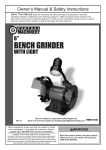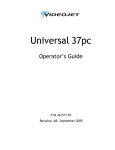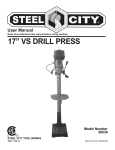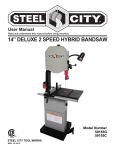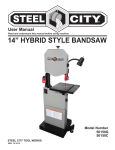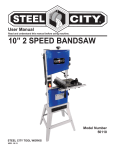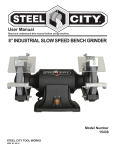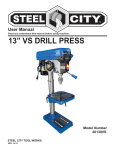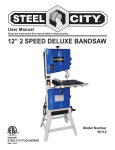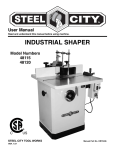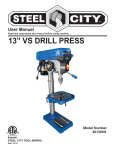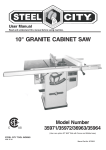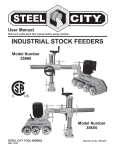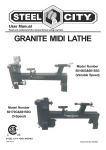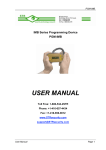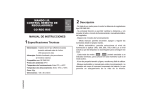Download 8” INDUSTRIAL SLOW SPEED BENCH GRINDER
Transcript
User Manual Read and understand this manual before using machine. 8” INDUSTRIAL SLOW SPEED BENCH GRINDER Model Number 15430 STEEL CITY TOOL WORKS VER. 8.13 TABLE OF CONTENTS 3URGXFW6SHFLILFDWLRQV............................................................................................................................................................. 'HILQLWLRQRI7HUPV................................................................................................................ )HDWXUH,GHQWLILFDWLRQ.............................................................................................................................................................. *HQHUDO6DIHW\............................................................................................................................................................. Product Safety ...................................................................................................................................................................... Electrical Requirements........................................................................................................................................................ Unpacking & Inventory..........................................................................................................................................................1 Assembly ...............................................................................................................................................................................1 Adjustments ...........................................................................................................................................................................1 Operations ............................................................................................................................................................................ Maintenance ....................................................................................................................................................... ..................... Troubleshooting .................................................................................................................................................................... ,1752'8&7,21 This user manual is intended for use by anyone working with this machine. It should be kept available for immediate reference so that all operations can be performed with maximum efficiency and safety. Do not attempt to perform maintenance or operate this machine until you have read and understand the information contained in this manual. I The drawings, illustrations, photographs, and specifications in this user manual represent your machine at time of print. However,changes may be made to your machine or this manual at any time with no obligation to Steel City Tool Works. 1 PRODUCT SPECIFICATIONS 8” BENCH GRINDER MOTOR Type Induction, Ball Bearing Horsepower Continuous duty 3/4H Amps 6 Volts 120 Phase Single Hertz 60 RPM 1725 (no load speed) Grinding Wheel Size 8” diameter x 1” face x 5/8” bore Grinding Wheel Grit 36gr, 100gr Shaft Diameter 5/8” Tool Rests Left and Right Eye Shield Assembly Left and Right (clear Lexan) Spark Arrestors Left and Right PRODUCT DIMENSIONS SHIPPING DIMENSIONS Length 19” Carton Type Cardboard Box Width 14” Length 23-1/2” Height 13” Width 15” Weight 75 Lbs. Height 14” Gross Weight 79 Lbs. 2 ACCESSORIES AND ATTACHMENTS Model 80200 Stand Model 80300 folding Stand Visit www.steelcitytoolworks.com for updates and visit www.youtube.com/user/SteelCityToolWorks DEFINITION OF TERMS Inner Wheel Guard Covers the grinding wheel and protects against accidental contact. Grinding Wheels (medium and coDUVH) Used to remove lighter and heavier material from workpiece. Adjustable Tool Rests Used to support the workpiece at selected angles. On/Off Switch Toggle with removable key. Adjustable Tool Rest Supports Allows for repositioning of tool rests as the wheels wear smaller. Eyeshields Protective Lexan see-thru shields to prevent any loose debris from contacting operator. Micro Wheel Balancer Used to distribute the load of the hex lock nuts in securing grinding wheels and to balance wheels. Arbor Hex Nut Used to secure the grinding wheels to the grinder. 3 FEATURE IDENTIFICATION C B A D E I F H G A) Inner Wheel Guard E) Grinding Wheel (coarse) B) Motor Housing F) C) Spark Arrestor G) Tool Rest Adjustable Supports D) Eye Shield H) On/Off Toggle Switch Tool Rest 4 I) Grinding Wheel (medium) GENERAL SAFETY ! ! WARNING WARNING TO AVOID serious injury and damage to the machine, read and follow all Safety and Operating Instructions before assembling and operating this machine. This manual is not totally comprehensive. It does not and can not convey every possible safety and operational problem which may arise while using this machine. The manual will cover many of the basic and specific safety procedures needed in an industrial environment. Exposure to the dust created by power sanding, sawing, grinding, drilling and other construction activities may cause serious and permanent respiratory or other injury, including silicosis (a serious lung disease), cancer, and death. Avoid breathing the dust, and avoid prolonged contact with dust. The dust may contain chemicals known to the State of California to cause cancer, birth defects or other reproductive harm. All federal and state laws and any regulations having jurisdiction covering the safety requirements for use of this machine take precedence over the statements in this manual. Users of this machine must adhere to all such regulations. Some examples of these chemicals are: Lead from lead-based paints. Crystalline silica from bricks, cement and other masonry products. Arsenic and chromium from chemically-treated lumber. Below is a list of symbols that are used to attract your attention to possible dangerous conditions. ! This is the international safety alert symbol. It is used to alert you to potential personal injury hazards. Obey all safety messages that follow this symbol to avoid possible injury or death. ! Always operate tool in well ventilated area and provide for proper dust removal. Use a dust collection system along with an air filtration system whenever possible. Always use properly fitting NIOSH/OSHA approved respiratory protection appropriate for the dust exposure, and wash exposed areas with soap and water. DANGER Indicates an imminently hazardous situation which, if not avoided, WILL result in death or serious injury. ! 1. To avoid serious injury and damage to the machine, read the entire User Manual before assembly and operation of this machine. WARNING Indicates a potentially hazardous situation which, if not avoided, COULD result in death or serious injury. ! CAUTION ! WARNING Indicates a potentially hazardous situation, if not avoided, MAY result in minor or moderate injury. It may also be used to alert against unsafe practices. 2. ALWAYS wear eye protection. Any machine can throw debris into the eyes during operations, which could cause severe and permanent eye damage. Everyday eyeglasses are NOT safety glasses. ALWAYS wear Safety Goggles (that comply with ANSI standard Z87.1) when operating power tools. CAUTION CAUTION used without the safety alert symbol indicates a potentially hazardous situation which, if not avoided, may result in property damage. NOTICE This symbol is used to alert the user to useful information about proper operation of the machine. 5 ! 11. DO NOT FORCE the machine to perform an operation for which it was not designed. It will do a safer and higher quality job by only performing operations for which the machine was intended. WARNING 12. DO NOT stand on a machine. Serious injury could result if it tips over or you accidentally contact any moving part. 3. ALWAYS wear hearing protection. Plain cotton is not an acceptable protective device. Hearing equipment should comply with ANSI S3.19 Standards. ! 13. DO NOT store anything above or near the machine. 14. DO NOT operate any machine or tool if under the influence of drugs, alcohol, or medication. WARNING 15. EACH AND EVERY time, check for damaged parts prior to using any machine. Carefully check all guards to see that they operate properly, are not damaged, and perform their intended functions. Check for alignment, binding or breakage of all moving parts. Any guard or other part that is damaged should be immediately repaired or replaced. 4. ALWAYS wear a NIOSH/OSHA approved dust mask to prevent inhaling dangerous dust or airborne particles. 16. Ground all machines. If any machine is supplied with a 3-prong plug, it must be plugged into a 3contact electrical receptacle. The third prong is used to ground the tool and provide protection against accidental electric shock. DO NOT remove the third prong. 5. ALWAYS keep the work area clean, well lit, and organized. DO NOT work in an area that has slippery floor surfaces from debris, grease, and wax. 6. ALWAYS unplug the machine from the electrical receptacle before making adjustments, changing parts or performing any maintenance. 17. Keep visitors and children away from any machine. DO NOT permit people to be in the immediate work area, especially when the machine is operating. 7. AVOID ACCIDENTAL STARTING. Make sure that the power switch is in the “OFF” position before plugging in the power cord to the electrical receptacle. ! 18. KEEP protective guards in place and in working order. 19. MAINTAIN your balance. DO NOT extend yourself over the tool. Wear oil resistant rubber soled shoes. Keep floor clear of debris, grease, and wax. WARNING 20. MAINTAIN all machines with care. ALWAYS KEEP machine clean and in good working order. KEEP all blades and tool bits sharp. 21. NEVER leave a machine running, unattended. Turn the power switch to the OFF position. DO NOT leave the machine until it has come to a complete stop. 8. AVOID a dangerous working environment. DO NOT use electrical tools in a damp environment or expose them to rain or moisture. ! 22. REMOVE ALL MAINTENANCE TOOLS from the immediate area prior to turning the machine ON. WARNING 23. SECURE all work. When it is possible, use clamps or jigs to secure the workpiece. This is safer than attempting to hold the workpiece with your hands. 24. STAY ALERT, watch what you are doing, and use common sense when operating any machine. DO NOT operate any machine tool while tired or under the influence of drugs, alcohol, or medication. A moment of inattention while operating power tools may result in serious personal injury. 9. CHILDPROOF THE WORKSHOP AREA by removing switch keys, unplugging tools from the electrical receptacles, and using padlocks. 10. DO NOT use electrical tools in the presence of flammable liquids or gasses. 6 28. SAVE these instructions and refer to them frequently and use them to instruct other users. 25. USE ONLY recommended accessories. Use of incorrect or improper accessories could cause serious injury to the operator and cause damage to the machine. If in doubt, DO NOT use it. 29. Information regarding the safe and proper operation of this tool is also available from the following sources: Power Tool Institute 1300 Summer Avenue Cleveland, OH 44115-2851 www.powertoolinstitute.org National Safety Council 1121 Spring Lake Drive Itasca, IL 60143-3201 American National Standards Institute 25West 43rd. St, 4th Floor New York, NY. 10036 ANSI 01.1 Safety Requirements For Woodworking Machines WWW.ANSI.ORG U.S. Department of Labor Regulations OSHA 1910.213 Regulations WWW.OSHA.GOV 26. THE USE of extension cords is not recommended for 230V equipment. It is better to arrange the placement of your equipment and the installed wiring to eliminate the need for an extension cord. If an extension cord is necessary, refer to the chart in the Grounding Instructions section to determine the minimum gauge for the extension cord. The extension cord must also contain a ground wire and plug pin. 27. Wear proper clothing, DO NOT wear loose clothing, gloves, neckties, or jewelry. These items can get caught in the machine during operations and pull the operator into the moving parts. Users must wear a protective cover on their hair, if the hair is long, to prevent it from contacting any moving parts. PRODUCT SAFETY 6. Safety decals are on this machine to warn and direct you to how to protect yourself or visitors from personal injury. These decals MUST be maintained so that they are legible. REPLACE decals that are not legible. 1. Serious personal injury may occur if normal safety precautions are overlooked or ignored. Accidents are frequently caused by lack of familiarity or failure to pay attention. Obtain advice from supervisor, instructor, or another qualified individual who is familiar with this machine and its operations. 7. DO NOT leave the unit plugged into the electrical outlet. Unplug the unit from the outlet when not in use and before servicing, performing maintenance tasks, or cleaning. 2. Every work area is different. Always consider safety first, as it applies to your work area. Use this machine with respect and caution. Failure to do so could result in serious personal injury and damage to the machine. 8. ALWAYS turn the power switch “OFF” before unplugging the bench grinder. 3. Prevent electrical shock. Follow all electrical and safety codes, including the National Electrical Code (NEC) and the Occupational Safety and Health Regulations (OSHA). All electrical connections and wiring should be made by qualified personnel only. ! ! WARNING WARNING 9. DO NOT handle the plug or bench grinder with wet hands. 10. USE accessories only recommended by Steel City. 11. DO NOT pull the bench grinder by the power cord. NEVER allow the power cord to come in contact with sharp edges, hot surfaces, oil or grease. 4. TO REDUCE the risk of electrical shock. DO NOT use this machine outdoors. DO NOT expose to rain or moisture. Store indoors in a dry area. 12. DO NOT unplug the bench grinder by pulling on the power cord. ALWAYS grasp the plug, not the cord. 5. STOP using this machine, if at any time you experience difficulties in performing any operation. Contact your supervisor, instructor or machine service center immediately. 7 13. REPLACE a damaged cord immediately. DO NOT use a damaged cord or plug. DO NOT use if the bench grinder is not operating properly, or has been damaged, left outdoors or has been in contact with water. 19. DO NOT stand in front of the bench grinder when starting it. Stand to one side and turn the bench grinder ON. Wait at the side for one minute until the grinder comes up to full speed. There is always a possibility that debris from a damaged grinding wheel may be discharged toward the operator. 14. DO NOT use the bench grinder as a toy. DO NOT use near or around children. 15. ALWAYS wear eye protection. The operation of any grinder can result in debris being thrown into your eyes, causing severe eye damage. Everyday glasses are not safety glasses. Wear safety glasses that comply with ANSI standard Z87.1 20. Sparks and debris are normally produced during grinding operations. BE SURE that there are not any flammable materials in the vicinity. Frequently clean grinding dust from the back of bench grinder. 16. ALWAYS use the eye shields and wheel guards provided with the grinder. 17. REPLACE a cracked or damaged grinding wheel immediately. A damaged wheel can discharge debris at a high velocity towards the operator. Carefully handle the grinding wheel since it is abrasive. Prior to replacing a grinding wheel, check it for cracks. Do not remove the labels from a grinding wheel. Tighten the spindle nut just enough to hold the grinding wheel firmly to the bench grinder. Do not overtighten, excessive clamping force can damage the grinding wheel. Only use the wheel flanges provided with the grinder. When selecting a replacement grinding wheel, verify that the grinding wheel has a higher RPM rating than the maximum RPM of the bench grinder. 21. NEVER force the workpiece against a grinding wheel, especially if the wheel is cold. Apply the workpiece slowly, allowing the grinding wheel an opportunity to warm up. This will minimize the chance of wheel breakage. DO NOT grind using the sides of the grinding wheels. DO NOT apply coolant directly to the grinding wheel. 22. NEVER use the bench grinder with the wheel guards removed. 23. ALWAYS keep the tool rests firmly tightened. 24. ALWAYS use the supplied wheel dresser to resurface the grinding wheel faces. 18. BE AWARE that the diameter of a grinding wheel will decrease with use. Adjust the tool rests and spark arrestors to maintain a distance of 1/16” from the wheel. ELECTRICAL REQUIREMENTS TO PREVENT electrical shock, follow all electrical and safety codes, including the National Electrical Code (NEC) and the Occupational Safety and Health Regulations (OSHA). All electrical connections and wiring should be made by qualified personnel only. DO NOT connect the machine to the power source before you have completed the set up process. TO REDUCE the risk of electrical shock, DO NOT use machine outdoors. DO NOT expose to rain or moisture. Store indoors in a dry area. The motors in these machines are designed to run on 120 volts. DO NOT connect the machine to the power source until instructed to do so. GROUNDING INSTRUCTIONS ! WARNING This machine MUST BE GROUNDED while in use to protect the operator from electric shock. If a plug is provided with your machine DO NOT modify the plug. If it will not fit your electrical receptacle, have a qualified electrician install the proper connections to meet all electrical codes local and state. All connections must also adhere to all of OSHA mandates. In the event of a malfunction or breakdown, GROUNDING provides the path of least resistance for electric current and reduces the risk of electric shock. The plug MUST be plugged into a matching electrical receptacle that is properly installed and grounded in accordance with ALL local codes and ordinances. IMPROPER ELECTRICAL CONNECTION of the equipment-grounding conductor can result in risk of electric shock. The conductor with the green insulation (with or without yellow stripes) is the equipment-grounding conductor. DO NOT connect the equipment-grounding conductor to a live termina. 8 The motor supplied with your machine is a 120 volt, 60 hertz, single phase motor. Never connect the green or ground wire to a live terminal. Check with a qualified electrician or service personnel if you do not completely understand the grounding instructions, or if you are not sure the tool is properly grounded. A machine with a 120 volt plug should only be connected to an outlet having the same configuration as the plug. Fig. A EXTENSION CORDS ! WARNING To reduce the risk of fire or electrical shock, use the proper gauge of extension cord. When using an extension cord, be sure to use one heavy enough to carry the current your machine will draw. Fig. B The smaller the gauge-number, the larger the diameter of the extension cord is. If in doubt of the proper size of an extension cord, use a shorter and thicker cord. An undersized cord will cause a drop in line voltage resulting in a loss of power and overheating. ! CAUTION USE ONLY a 3-wire extension cord that has a 3-prong grounding plug and a 3-pole receptacle that accepts the machine’s plug. If you are using an extension cord outdoors, be sure it is marked with the suffix “W-A” (“W” in Canada) to indicate that it is acceptable for outdoor use. Make certain the extension cord is properly sized, and in good electrical condition. Always replace a worn or damaged extension cord immediately or have it repaired by a qualified person before using it. PLUGS/RECEPTACLES ! Protect your extension cords from sharp objects, excessive heat, and damp or wet areas. WARNING MINIMUM RECOMMENDED GAUGE FOR EXTENSION CORDS (AWG) Electrocution or fire could result if this machine is not grounded properly or if the electrical configuration does not comply with local and state electrical codes. 120 VOLT OPERATION ONLY MAKE CERTAIN the machine is disconnected from power source before starting any electrical work. 25’ LONG 50’ LONG 100’ LONG 150’ LONG 0 to 6 Amps 18 AWG 16 AWG 16 AWG 14 AWG 6 to 10 Amps 18 AWG 18 AWG 14 AWG 12 AWG 16 AWG 16 AWG 14 AWG 12 AWG 10 to 12 Amps MAKE SURE the circuit breaker does not exceed the rating of the plug and receptacle. 9 UNPACKING & INVENTORY Compare the items to inventory figures; verify that all items are accounted for before discarding the shipping box. Check shipping carton and machine for damage before unpackaging. Carefully remove packaging materials, parts and machine from shipping carton. Always check for and remove protective shipping materials around motors and moving parts. Lay out all parts on a clean work surface. ! WARNING If any parts are missing, do not attempt to plug in the power cord and turn “ON” the machine. The machine should only be turned “ON” after all the parts have been obtained and installed correctly. For missing parts, contact Steel City at 1-877-SC4-TOOL. Remove any protective materials and coatings from all of the parts and the table saw. The protective coatings can be removed by spraying WD-40 on them and wiping it off with a soft cloth. This may need redone several times before all of the protective coatings are removed completely. J B C L D K A I H M G F E N A) Spark Arrestors (2) H) #1/4-20 Pan Head Screw (2) B) #3/16” 24 x 3/8” Pan Head Screw (4) I) C) 3/16” Flat Washers (4) J) Eyeshields (2) D) 3/16” Nut K) Eyeshield Support Bracket (2) E) 5/16” Nut (4) L) Eyeshield Mounts (2) F) #5/16-18 x 1 1/4” Carriage Bolt (2) M) #5/16-18 x 3/4 Carriage Bolts (2) G) 5/16” Flat Washers (4) N) Tool Rests (2) 10 Tool Rest Supports (2) ASSEMBLY ! Fig.5B WARNING MAKE CERTAIN THAT THE GRINDER IS DISCONNECTED FROM THE POWER SOURCE BEFORE ANY ASSEMBLY IS STARTED. C An open end wrench is required for assembly of the tool rests and spark arrestors. DO NOT assemble the bench grinder until you are sure the tool is not plugged in. DO NOT assemble the bench grinder until you are sure the power switch is in the OFF position. B DO NOT assemble the bench grinder until you are sure the grinding wheels are firmly tightened to the bench grinder. TOOL RESTS 3. Loosen and remove nut (B) washer (C). 4. Install bracket (A) with tool rest attached. 5. Install washer (C), nut (B) and tighten (Fig.5C). The bench grinders are provided with two tool rest assemblies, the left and the right. Fig.5C Remove tool rest assemblies from the plastic bags and confirm that you have the following: Left side tool rest and tool rest support Right side tool rest and tool rest support Flat washers (2) 5/16 x 1 1/4”Carriage Bolts (2) 5/16” Nuts (2) Fig.5A A C A D Fig.6 B 1. Place carriage bolt (D) in bracket (A). 2. Attach washer (C) and nut (B) Fig.5A. 6. Tilt to meet desired angle and secure (Fig.6). 11 SPARK ARRESTORS Fig.7 Fig.7A Remove spark arrestor assemblies from the plastic bags and confirm that you have the following: Left side spark arrestor Right side spark arrestor A 1. Remove screw (A) Fig.7. 2. Install Spark Arresstor (B) adjust to just above the wheel and tighten screw Fig.7A. B EYE SHIELDS Remove eye shield assemblies from the plastic bags and confirm that you have the following (shown in Fig.8 for each side): Eye Shields Nuts Flat Washers Screws Fig.8 1. Choose left or right bracket (Fig.8A). 2. Using hardware shown in Fig.8, assemble with Philipps screw driver (not provided) as shown in Fig.8B and tighten. Fig.8A 3. Fig.8C attach bracket (A) into eye shield assembly using carriage bolt (B), washer (C), nut (D). Assembly now shown in Fig.8D. Fig.8B 4. Loosen nut and washer (Fig.8E). 5. Install bracket, washer, nut (Fig.8F). 6. Tighten to desired location (Fig.8G). 7. Repeat for other side. B A C Fig.8C D Fig.8D Fig.8E Fig.8G Fig.8F 12 DUST PORT There is a dust port located on the inner side of each Inner Wheel Guard. These dust ports allow the grinding dust to exit the wheel cavity. Compress flexible hose between ports and connect your dust collector (Fig.9, 9A, 9B). Fig.9 Fig.9A Fig.9B PERMANENT MOUNTING You should firmly attach the Bench Grinder to a solid work surface or heavy-duty stand (hardware not included). ! WARNING If the Bench Grinder is not securely mounted, it will have the ability to move or tip over during grinding operations and possibly cause the operator’s fingers to contact the grinding wheels. 13 ADJUSTMENTS ! WARNING ALWAYS wear eye protection. ! WARNING DO NOT touch grinding wheels with fingers. B A C CHANGING THE GRINDING WHEEL Due to normal wear, grinding wheels will occasionally need replacement. I L Fig.10 1. Turn the power switch OFF and unplug the power cord from its power source. 2. Rotate the eyeshields to the UP position for access to the tool rests. J H 3. Remove the 5 screws (A), spark arrestor (B), and cover (C). SEE FIG.10. Fig.10A 4. Place a small wooden wedge between the abrasive wheel and tool rest to prevent the wheels from rotating. 5. Remove the right side grinding wheel by turning the lock-nut (H) in the counterclockwise direction with an open-end wrench (not included). The left side wheel can be removed by turning the lock-nut in the clockwise direction with an open-end wrench. SEE FIG.10A. 6. Remove the outer wheel flange balancer (I) and then remove the abrasive wheel from the arbor shaft (J). The inner wheel flange (L) does not need to be removed. Fig.10B BALANCE WHEELS The grinding wheels have been balanced at time of assembly. If you change the grit of a wheel you will need to balance again. The flange is the balancer and by loosening the set screws, shifting the weights in the slot, and tightening, you too will be able to balance your wheels. Process may need repeating a few times to achieve balance. SEE FIG.11. 7. CAUTION: The new abrasive wheel to be put on the bench grinder must have a higher RPM rating than the bench grinder. The label on the side of the abrasive wheels must stay on. DO NOT remove this label. 8. Replace the abrasive wheel, outer wheel flange balancer, and the lock-nut in reverse order from removal. ! CAUTION DO NOT OVER-TIGHTEN the lock nut as this may damage the abrasive wheels and cause serious injury to the operator. NOTE: A wire wheel or a buffing wheel can be used with your grinder. Depending on the thickness of the wheel, you will need to add one or more spacers (not included) to allow the arbor hex nut to tighten correctly. These spacers are identical to each other. One spacer should always go onto the arbor shaft first. The second spacer, if needed, will go on next to the Fig.11 14 OPERATIONS ! WARNING MAKE CERTAIN THAT THE BENCH GRINDER IS DISCONNECTED FROM THE POWER SOURCE. ! WARNING ALWAYS wear eye protection. Any machine can throw debris into the eyes during operations, which could cause severe and permanent eye damage. Everyday eyeglasses are NOT safety glasses. ALWAYS wear Safety Goggles (that comply with ANSI standard Z87.1) when operating power tools. ! WARNING ALWAYS wear a NIOSH/OSHA approved dust mask to prevent inhaling dangerous dust or airborne particles. The bench grinder is designed for hand held grinding, sharpening, and cleaning operations. ALWAYS wear eye protection. Hot sparks are produced during grinding operations. 1. The power switch must be in the OFF position. 2. Stand to the side of bench grinder and plug in the power cord to a suitable power source. 3. Remain to the side of the bench grinder and turn it ON. 4. Allow the grinding wheels to come up to a steady speed for at least a minute. 5. Adjust the eye shields. Place the workpiece on the appropriate tool rest for the desired operation. NOTICE: 6. Move the workpiece towards the grinding wheel until it lightly touches the wheel. Move the workpiece back and forth across the front surface of the grinding wheel, removing the amount of material desired. The following section was designed to give instructions on the basic operations of this bench grinder. However, it is in no way comprehensive of every grinder application. It is strongly recommended that you read books, trade magazines, or get formal training to maximize the potential of your grinder and to minimize the risks. 7. Remove key when hot in use (Fig.12). ! WARNING TO AVOID SERIOUS INJURY, NEVER GRIND ON THE SIDES OF THE GRINDING WHEELS. 8. The operator may place the hot end of the workpiece into the water in the quench tray (not supplied) to cool it 9. After completing the grinding operations, turn OFF the bench grinder. CAUTION: it will take a few minutes for the grinding wheels to come to a complete stop. 10. Avoid contact with grinder housing until it is cool. Unplug the bench grinder from the power source. NOTE: To prevent unauthorized use of the bench grinder, the power switch has a removable locking key. With the power switch in the OFF position, pull the locking key out. The bench grinder cannot be turned ON with the key removed. Insert the locking key to resume grinding operations. Fig.12 15 MAINTENANCE ! CAUTION: Check all nuts, screws, and sheilds. Tighten or replace as needed as per your maintenance schedule. WARNING TURN THE POWER SWITCH OFF AND UNPLUG THE POWER CORD FROM ITS POWER SOURCE PRIOR TO ANY MAINTENANCE. CAUTION: Replace the abrasive wheels if there is any damage at all. FAILURE to replace a damaged wheel can cause serious injury to the operator. LUBRICATION CAUTION: Do not use flammable materials to clean the bench grinder. A clean dry rag or brush is all that is needed to remove dust and debris buildup. The bench grinder has sealed, lubricated bearings in the motor housing that do not require any additional lubrication by the operator. ! CLEANING Repairs to the bench grinder should be performed by trained personnel only. Unauthorized repairs or replacements with non-factory parts could cause serious injury to the operator and damage to the bench grinder. With the bench grinder unplugged, rotate the abrasive wheels slowly and inspect for any damaged or trapped shavings. ! WARNING WARNING BE SURE to wear protective eyewear and dust mask when cleaning the grinder. 16 TROUBLESHOOTING GUIDE To prevent injury to yourself or damage to the bench grinder, turn the switch to the OFF position and unplug the power cord from the electrical receptacle before making any adjustments. PROBLEM LIKELY CAUSE(S) SOLUTION Motor does not run. 1. 2. 3. 4. 5. Motor does not have full power. 1. Incorrect line voltage. 2. Damaged motor. 1. Have a qualified electrician check line for proper voltage. 2. Return to SCTW distributor. Motor runs hot. 1. Motor is overloaded. 2. Poor air circulation around motor. 1. Reduce pressure on workpiece. 2. Remove any blockage around motor. Motor stalls or runs slow. 1. Motor is overloaded. 2. Incorrect line voltage. 3. Capacitor has failed. 1. Reduce pressure on workpiece. 2. Have a qualified electrician check line for proper voltage. 3. Replace capacitor. Fuse blows or circuit breaker trips. 1. 2. 3. 4. 1. 2. 3. 4. Machine not plugged in. Power switch in OFF position. Power cord is faulty. Fuses or circuit breaker is open. Damaged motor. 1. 2. 3. 4. 5. Motor overloaded. Overloaded electrical circuit breaker. Wrong fuse or circuit breaker. Undersized or excessive length of extension cord, see manual. 5. Grinding wheels are blocked. Plug power cord into electrical receptacle. Flip switch to ON position. Replace power cord. Overloaded electrical circuit. Return to SCTW distributor. Reduce pressure on workpiece. Reduce the amount of items on circuit. Replace with correct fuse or circuit breaker. Use correct size. 5. Unplug machine and remove obstruction. NOTES www.steelcitytoolworks.com Steel City Tool Works, LLC Bolingbrook, IL. USA 60440 Tech Service: 1.877.724.8665



















